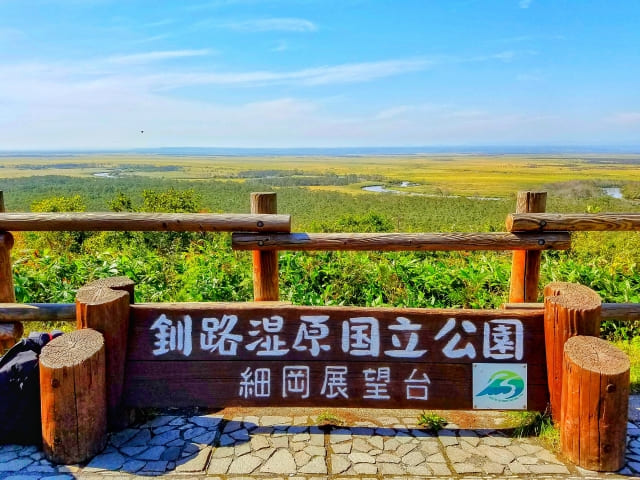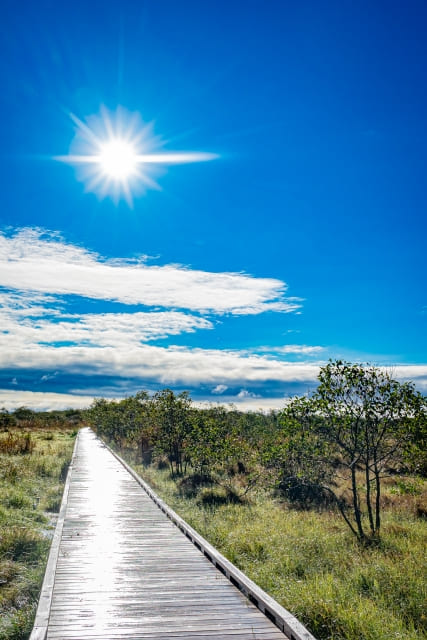Kushiro Shitsugen National Park – Japan’s Largest Wetland
Overview: A Vast Marshland Home to Rare Wildlife and Scenic Trails
Kushiro Shitsugen National Park (釧路湿原国立公園) is Japan’s largest wetland, stretching across eastern Hokkaido. The park is renowned for its sprawling marshes, meandering rivers, and as a sanctuary for the endangered Japanese red-crowned crane (tancho). Visitors can enjoy panoramic views from observatories, walk along wooden boardwalks, and experience the tranquility of the wetlands by canoe. For more ideas on what to see nearby, check out the "Find Recommended Sightseeing Spots Near Kushiro Shitsugen" section below!



History and Cultural Significance
Kushiro Shitsugen has long been revered by the Ainu people, Hokkaido’s indigenous inhabitants, as a sacred landscape. The park was designated in 1987 to protect its unique ecosystem and the endangered red-crowned crane. Today, it is a symbol of wildlife conservation in Japan and a haven for nature lovers, photographers, and birdwatchers.
Local Legend: The Spirit of the Wetlands
Local folklore speaks of the wetlands as the “land of mist and cranes,” where the spirits of nature dwell. The elegant tancho crane is considered a symbol of longevity and good fortune in Japanese culture.
Local saying:
「釧路湿原のタンチョウは幸運の象徴」
Translation:
"The red-crowned crane of Kushiro Shitsugen is a symbol of good luck."
Click here to search and reserve hotels or airline tickets for your Hokkaido trip.
How to Get to Kushiro Shitsugen National Park (Last updated: June 11 , 2025)
| Departure Station | Route | Estimated Time | Estimated Cost |
|---|---|---|---|
| JR Kushiro Station | JR Senmo Line (local train) → JR Kushiro Shitsugen Station | Approx. 20 min | ¥470 |
| Kushiro Airport | Airport Shuttle Bus → JR Kushiro Station → JR Senmo Line → JR Kushiro Shitsugen Station | Approx. 1 hr | ¥1,200–¥1,500 |
| JR Abashiri Station | JR Senmo Line (toward Kushiro) → JR Kushiro Shitsugen Station | Approx. 3 hr 30 min | ¥4,000 |
| JR Mashu Station | JR Senmo Line (toward Kushiro) → JR Kushiro Shitsugen Station | Approx. 1 hr 10 min | ¥1,800 |
| *Trains are infrequent; check the timetable in advance. The station is unmanned and has basic facilities only. | |||
From JR Kushiro Shitsugen Station, the
Hosooka
Observatory is a 10-minute walk. Local taxis are available by phone
reservation, but walking is recommended for the full wetland experience.
Tip: Bring snacks and drinks, as there are no shops at the station.
Note: There are two stations that provide access to different areas of Kushiro Shitsugen National Park. Kushiroshitsugen Station (釧路湿原駅) is closest to the Hosooka Observatory on the eastern side of the wetlands. Kushiro Shitsugen Station (釧路湿原駅) serves the western side near the Onnenai Boardwalk and Visitor Center. Be sure to check which area you’re heading to before choosing your train stop.
Recommended Sightseeing Spots Near Kushiro Shitsugen National Park
The Kushiro Shitsugen area is surrounded by scenic observatories, tranquil lakes, and unique experiences that showcase the natural beauty and wildlife of Hokkaido’s largest wetland. Here are some highlights to explore nearby:
- JR Kushiro Shitsugen Station: The main gateway to the wetlands, offering direct access to walking trails and the Hosooka Observatory.
- Hosooka Observatory / Kushiro Marsh Observatory / Hokuto Observation Area / Yumegaoka Observatory / Sarubo Observatory / Kottaro Marsh Observatory: Multiple observatories provide panoramic views of the marshlands, winding rivers, and seasonal wildlife. Each spot offers unique perspectives for birdwatching and photography.
- Onnenai Boardwalk & Visitor Center: Walk above the marsh on wooden paths and learn about the wetland ecosystem at the visitor center.
- Lake Takkobu & Lake Toro: Peaceful lakes ideal for canoeing, birdwatching, and relaxing in nature. In winter, Lake Toro is famous for smelt ice-fishing.
- Kushiro Shitsugen Norokko Train: Enjoy a scenic railway journey through the wetlands, with open-air cars perfect for viewing wildlife and landscapes.
Whether you’re seeking panoramic views, immersive boardwalks, or unique seasonal activities, the Kushiro Shitsugen region offers something for every nature lover. Plan your visit to make the most of these recommended spots!
Access on Foot (From Station to Wetland Trails)
The main walking trail and boardwalk to the Hosooka Observatory start right outside the station. The area is flat and easy to explore on foot, with plenty of opportunities for birdwatching and photography.
In winter, the landscape transforms into a snowy wonderland, and you may spot red-crowned cranes in the fields nearby.
Activity Information
- Location: Kushiro Shitsugen National Park, Hokkaido, Japan
- Opening Hours: Park open 24h (observatories: 9:00 AM - 5:00 PM, varies by facility)
- Recommended Season: Spring–autumn (hiking, canoeing), winter (crane watching)
- Admission Fee: Free (some observatories: ¥470–¥600)
- Special Events: Crane viewing (Nov–Mar), nature walks (summer)
- Notes: Some areas are only accessible by car or taxi; canoe tours are seasonal.